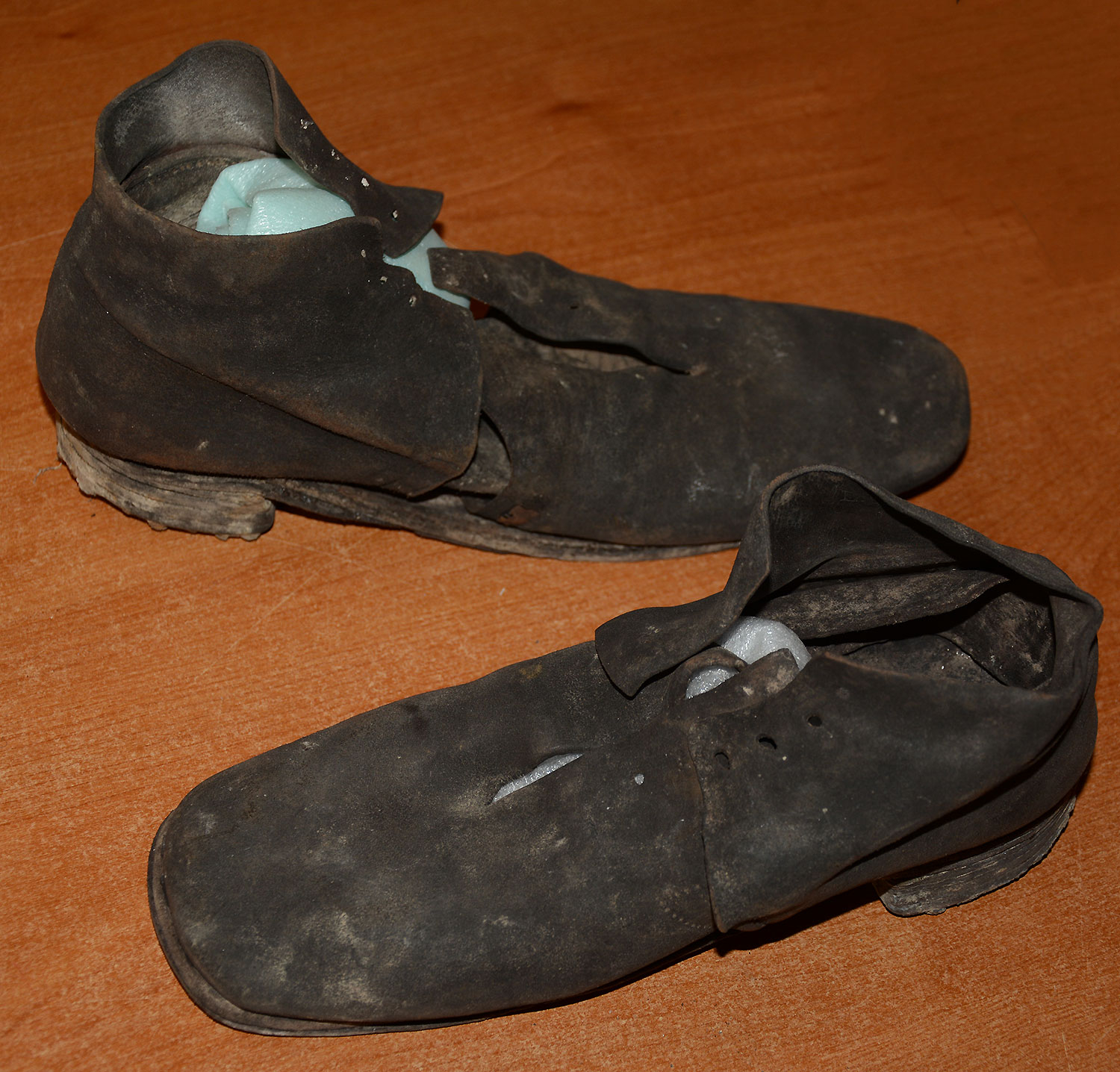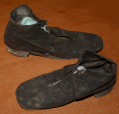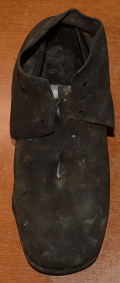site search
online catalog
SCARCE PAIR CIVIL WAR ARMY ISSUE SHOES, MAKER MARKED, SOLDIER MODIFIED, LOTS OF MARCHING!

$1,850.00 SOLD
Quantity Available: None
Item Code: 1052-281
This pair of Civil War US army issue shoe show an interesting field alteration by the soldier: a 3 ½ inch slit down the upper end of the tongue of each for comfort- one of several alterations we have seen over the years made by soldiers to U.S. army issue shoes, which were hardly known known for custom fitting. They both show wear to the soles from extensive marching, certainly the reason they were discarded. Nevertheless, they display well, one particularly so, are very tough to find. They are typical wartime construction as supplied through government depots and both bear a clear “L.T.” stamp inside the right ankle that certainly the army contractor who supplied them, or possibly a government worker if made within a depot. The body uses rough-side out black leather two-piece uppers consisting of vamp and quarters, sewn together low on the instep, with reinforcing heel piece or “counter” sewn inside, four pairs of holes for a leather thong/lace (along with a single hole on the tongue) square toe, nailed heel and sewn sole - one of the two general Civil War types: pegged or sewn (further broken down by hand or machine made) - not narrowly contoured but showing left and right. Both shoes are complete except for the lace/thong and the leather is stiff, but shows off well as a charcoal black with some small white or gray stains.
The left shoe is solid, holds together tightly, displays very well, and shows a wear spot on what would be the ball of the foot that exposed the inner sole, but did not go through. There is a short separation between the welt and the sole near the wear spot, but it is very slight and visible mostly only when looking at it from the bottom and at an angle. The stitching is mostly gone but the stiffness of the leather holds everything in place and together. The heel is firmly attached and the nails are present, though showing some dirt and corrosion of course. The right shoe is solid and displays well when stationary, but shows more wear on the sole and there is separation of the sole and heel from the uppers from the deterioration of the stitching. The heel is complete and intact with the layers tight and nails in place, though showing some corrosion and dirt on the bottom as with other shoe. The sole shows why they were discarded- the outer sole was worn through for about three inches back from the toes, pretty much under the toes and ball of the foot. The edge of the outer sole present around the hole as a narrow strip on the front and wearer’s left. This exposed the inner sole and the soldier wore it for a while longer, creating a smaller triangular hole in the inner sole as well, about ¾ by ¾ inch, with a short tear. It is clear he was making-do as long as he could.
These would easily be taken for a barn or attic-find, but in fact come from excavations at Fort Pembina, ND, conducted on private property with the owner’s consent, where anaerobic soil conditions have produced cloth and leather items in remarkable condition. (Think of Vindolanda in Britain, where similar soil conditions have produced leather, wood, etc., in remarkable condition after well over a thousand years.) The fort was established by two companies of the 20th U.S. Infantry in 1870, when troops were still clothed from the immense wartime stocks until patterns began to change around 1872, though wartime surplus continued to be issued. The modification of the tongues is an interesting personal touch and they seem to have been discarded by the soldier only because the wear, which indicates some long marches and active campaigning. Neither the field modification or retention even with extensive wear is surprising for a soldier at a small frontier fort who might be charged if exceeding his clothing allowance and where resupply might be problematical.
The fort was in operation until 1895. As is typical of the early Indian Wars regular army, the garrison’s uniforms and gear were a mix of Civil War surplus issue, private purchase material, and as time went on, later army issue patterns. Footwear was, of course, essential, but army issue shoes of the period are extremely scarce, particularly Civil War issue shoes since they were so readily worn out and discarded, or practical for postwar civilian use if they survived military use, and were uninspiring as relics of patriotic service. They are among the rarer pieces of Civil War uniforms and equipment despite being made in the millions. Philadelphia depot, for example, purchased some 3,231,647 pairs of sewn shoes and made others. New York distributed almost three million sewn pairs and well over three-hundred thousand pegged pairs. Cincinnati furnished more than two million pegged pairs and six million sewn. Some considered the soles too thin, but they were generally well regarded for use on southern roads, “where one hardly strikes a pebble in a mile.” It was complaints coming from troops serving in the postwar southwest where rough and rocky ground would cut stitching and tear off heels and cause wood pegs to pop out from dryness that eventually led to the use of brass screws starting with the pattern of 1872 and continued in the pattern of 1876, with the addition of a longer tongue. We recommend “The Army Shoe” by J.E. Tobey in the Columbia Rifles Research Compendium, as well as articles in Company of Military Historians, Brinkerhoff’s Boots and Shoes of the Frontier Soldier, and McChristian’s excellent volumes on the postwar US army.
Fort Pembina was situated in the Red River Valley in North Dakota near the Canadian border. Trading posts existed earlier in the area as part of the fur trade, and the first U.S. military post there was temporary- manned by a detachment of Minnesota troops in 1863-1864 following the 1862 Sioux uprising. In March 1870 a new fort was established south of the Pembina River and about 200 yards west of the Red River, completed by July and named in honor of Gen. George H. Thomas. The name was changed to Fort Pembina in September and the initial garrison consisted of two companies of the 20th US Infantry. Their main duty was to provide security for settlers worried about Sioux returning south from Canada, but the troops were often occupied with escorting boundary surveys along the Canadian border and preventing Fenian raids heading north into Canada.
The fort included enlistedmen’s barracks, officers’ quarters, guard house, ordnance storehouse, company kitchen, root house, laundress’s quarters, quarters for civilian employees, hospital and hospital servant’s house, a barn for the “hospital cow,” quartermaster and commissary offices and storehouse, stables, wagon shed, etc. The garrison reached peak strength in 1878 of 200, but the average was about 125 enlisted men and 8 officers. An October 1885 return listed 97 men, 2 field pieces, 1 mountain howitzer, 100 rifles, 19 pistols, 23 mules, and 9 wagons. By 1890 the post had just 23 men, and after an 1895 fire destroyed some 19 buildings it was decided to abandon the fort rather than rebuild, the last detachment left in September. The property was turned over to the Interior Department and later sold in 1902.
This is a legitimate, dead-real pair of Civil War issue shoes that display well, with one that holds together very well and can be readily handled. This pair would make a good addition both to a display of Civil War soldiers’ gear and to one focusing on the frontier army in the years immediately following the war. [sr] [ph:L]
~~~~~~~~~~~~~~~~~~~~~~~~~~~~~~~~~~~
THIS ITEM, AS WITH ALL OTHER ITEMS AVAILABLE ON OUR WEB SITE,
MAY BE PURCHASED THROUGH OUR LAYAWAY PROGRAM.
CLICK HERE FOR OUR POLICIES AND TERMS.
THANK YOU!
Inquire About SCARCE PAIR CIVIL WAR ARMY ISSUE SHOES, MAKER MARKED, SOLDIER MODIFIED, LOTS OF MARCHING!
For inquiries, please email us at [email protected]
Most Popular
Historical Firearms Stolen From The National Civil War Museum In Harrisburg, Pa »
Theft From Gravesite Of Gen. John Reynolds »
Fine Condition Brass Infantry Bugle Insignia »
Selection Of Unframed Prints By Don Troiani »
Wonderful Condition Original Confederate-Manufactured Kepi For A Drummer Boy Or Child »
featured item
CDV OF BRIGADIER GENERAL ELON J. FARNSWORTH, KILLED IN ACTION AT SOUTH CAVALRY FIELD, GETTYSBURG
Here’s your opportunity to own a scarcely found image of Brigadier General Elon Farnsworth, who commanded 1st Brigade, 3rd Division of the Army of the Potomac’s Cavalry Corps at Gettysburg where he met his demise in the ill-fated charge ordered… (2024-1113). Learn More »














